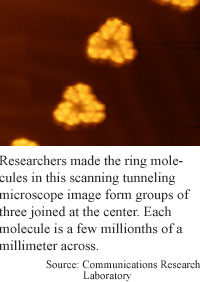
Chemists
create nano toolkit
By
Eric Smalley,
Technology Research NewsThe word 'chemistry' often conjures images of test tubes filled with strangely colored liquids. But those liquids are just the outward manifestation of what chemistry is really about -- creating and manipulating molecules.
Traditionally, chemists work with molecules to make substances with useful properties, from new drugs to better laundry detergent. In the brave new world of nanotechnology, chemists use molecules as building blocks for microscopic structures and machines.
Chemists have found an ally in some molecules that assemble themselves into specific shapes. So rather than having to build tiny objects molecule by molecule, researchers can harness this self-assembly skill to make the molecules do the work.
A team of researchers at the National Institute for Materials Science in Japan and the Communications Research Laboratory in Japan has come up with a kind of toolkit for building structures out of ring-shaped porphyrin molecules. Naturally occurring porphyrins include hemoglobin, which gives blood its red color, and chlorophyll, which makes plants green.
The researchers' synthetic porphyrin has four attachment points and the researchers can control which of the attachment points connect to a gold surface. With three points attached, the molecules assemble into rings of three connected at the center by the remaining attachment points. When two adjacent attachment points on each molecule are free, four-molecule rings form. When two opposite attachment points are free, the molecules form long chains across the surface.
The structures could be used to make molecular electronic and optoelectronic devices, said Shiyoshi Yokoyama, a senior researcher at the Communications Research Laboratory. For example, the chains could be used as extremely small wires.
The smallest wires used in today's integrated circuits are etched by narrowly focused lasers, but the finest lines they can make are about 150 nanometers wide. Experimental etching techniques have produced lines about 10 nanometers wide. The researchers' self-assembly approach produces chains of molecules that are about 3 nanometers wide, or about thirty times the diameter of a carbon atom. A nanometer is one millionth of a millimeter.
The researchers have made porphyrin chains as long as 100 nanometers and they have made the wires branch at selected points, said Yokoyama.
Creating tiny structures is only half the game, however. The researchers also need to make the structures do something, like conduct electricity or convert light signals to electric signals. But even if the porphyrin molecules were not useful by themselves they could be augmented by other atoms or molecules.
The molecules show some initial promise on their own: "Porphyrin molecules... show fluorescence behavior and perform interesting energetic transfers when they are bonded or arranged closely," said Yokoyama. The researchers have not yet determined how well the wires conduct electricity, however, he said. "In order to do this, we are making nanometer-scale electrodes."
One of the fundamental challenges in nanotechnology research in general is linking molecule-scale structures to the outside world. The key is getting the structures to form where researchers want them.
Yokoyama's team is also working on this problem. "One of the most important issues is placing the assemblies at the desired position, such as between nano-scale electrodes," he said.
The research is an advance in structural nanotechnology, said Yuji Okawa, a research scientist at Institute of Physical and Chemical Research (RIKEN) in Japan. "Many molecules have been proposed which will act as functional electronic devices," but the problem is no one has been able to build actual electronic devices out of them, he said.
The main challenge is efficiently positioning nano-sized molecules and connecting them into micro-sized patterns, said Okawa. "This work demonstrates that individual... molecules can be designed to control the size and the aggregation pattern of supramolecular structures," he said.
It's difficult to say when the technique could be used to make practical devices, said Yokoyama. "If we need only one or two functions, we can demonstrate them within five to ten years," he said.
Yokoyama's research colleagues were Takashi Yokoyama of the National Institute for Materials Science in Japan, and Toshiya Kamikado, Yoshishige Okuno and Shinro Mashiko of the Communications Research Laboratory in Japan. They published the research in the October 11, 2001 issue of the journal Nature. The research was funded by the Japanese government.
Timeline: 5-10 years
Funding: Government
TRN Categories: Nanotechnology; Materials Science and Engineering
Story Type: News
Related Elements: Technical paper, "Selective Assembly On a Surface of Supramolecular Aggregates With Controlled Size and Shape," Nature, October 11, 2001
Advertisements:
November 21, 2001
Page One
Chemists create nano toolkit
English could snowball on Net
Page age shapes Web
Circuits show six degrees of separation
Spot of gold makes tiny transistor

News:
Research News Roundup
Research Watch blog
Features:
View from the High Ground Q&A
How It Works
RSS Feeds:
News
Ad links:
Buy an ad link
| Advertisements:
|
 |
Ad links: Clear History
Buy an ad link
|
TRN
Newswire and Headline Feeds for Web sites
|
© Copyright Technology Research News, LLC 2000-2006. All rights reserved.